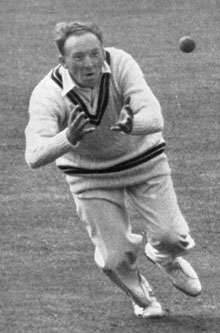Stuart Surridge
 | |||||||||||||||||||||||||||
| Personal information | |||||||||||||||||||||||||||
|---|---|---|---|---|---|---|---|---|---|---|---|---|---|---|---|---|---|---|---|---|---|---|---|---|---|---|---|
| Full name | Walter Stuart Surridge | ||||||||||||||||||||||||||
| Born |
3 September 1917 Herne Hill, London, England | ||||||||||||||||||||||||||
| Died |
13 April 1992 (aged 74) Glossop, Derbyshire | ||||||||||||||||||||||||||
| Batting style | Right-handed | ||||||||||||||||||||||||||
| Bowling style | Right-arm fast-medium | ||||||||||||||||||||||||||
| Role | Bowler, captain | ||||||||||||||||||||||||||
| Domestic team information | |||||||||||||||||||||||||||
| Years | Team | ||||||||||||||||||||||||||
| 1939 | Minor Counties | ||||||||||||||||||||||||||
| 1947–1959 | Surrey | ||||||||||||||||||||||||||
| Career statistics | |||||||||||||||||||||||||||
| |||||||||||||||||||||||||||
| Source: Cricinfo, 15 June 2013 | |||||||||||||||||||||||||||
Walter Stuart Surridge (3 September 1917 – 13 April 1992) was a cricketer who played for Surrey. He was born at Herne Hill in south London, educated at Emanuel School, and died at Glossop in Derbyshire.
Surridge was arguably the most successful cricket captain ever in the first-class game in England. Through relentlessly aggressive tactics, he turned an underperforming Surrey team into a record-breaking success in the County Championship of the 1950s. The county won the title in each of the five years he was captain, from 1952 to 1956, and then won two more under Peter May to create a sequence that has not been equalled.
Surridge came from a famous family of cricket bat makers. He was only a moderate cricketer: a lower order batsman whose principal talent was belligerence and a right-arm fast-medium bowler who was, by the standards of his time, somewhat expensive. He was 30 before he played first-class cricket, and was included in the Surrey side mainly when one of the team's England stars was playing Test cricket, which was fairly frequently.
Surrey's team in the early 1950s was overloaded with bowling talent. Alec Bedser was the main strike bowler for England for 10 seasons after the Second World War; Jim Laker was reckoned by most to be the best off spin bowler in England; Tony Lock was an aggressive slow left-arm bowler; and Peter Loader, though eclipsed in Test terms by Brian Statham and Fred Trueman, was a fast bowler of menace. Batting resources were thinner, but in Peter May Surrey had the most correct and fluent right-hand batsman to have emerged since the war.
Yet until Surridge became captain, a shared Championship in 1950 (with Lancashire) was the only success Surrey had had since before the First World War.
Surridge's methods were simple. He determined that bowlers and catches won matches, and he aimed to win as many matches as he could. He himself was a fearless fielder close to the wicket, and others followed his example.
In his five years as captain, only in 1953 did Surrey win less than half their matches; in 1955, the county won 23 out of 28 games, losing the other five and going through the whole season without a single draw. His tactics were sometimes ruthless. In one match against a weak Worcestershire, having dismissed his opponents for a total of 25 runs, Surridge declared the Surrey innings closed at just 92 for three wickets, and bowled Worcestershire out again for 40 to win by an innings and 27 runs. The weather forecast had not been good, he said. Even when Surrey's contingent of England cricketers was away on Test duty, Surridge conjured outstanding performances from their replacements.
The difference Surridge made to a talented collection of individuals was recognised when he was named as a Wisden Cricketer of the Year in 1953, but few other honours came his way, other than being chosen as President of Surrey in 1981 (his widow, Betty, was President in 1997). In retirement after 1956, he served on Surrey committees and ran his bat-making business, and was visiting his factory when he collapsed and died, aged 74. His son, also called Stuart, played once for Surrey in 1978.
References
External links
- Player profile: Stuart Surridge from CricketArchive
- Player profile: Stuart Surridge from ESPNcricinfo
- Stuart Surridge – Cricketer of the Year, 1953
- Surridge Sports